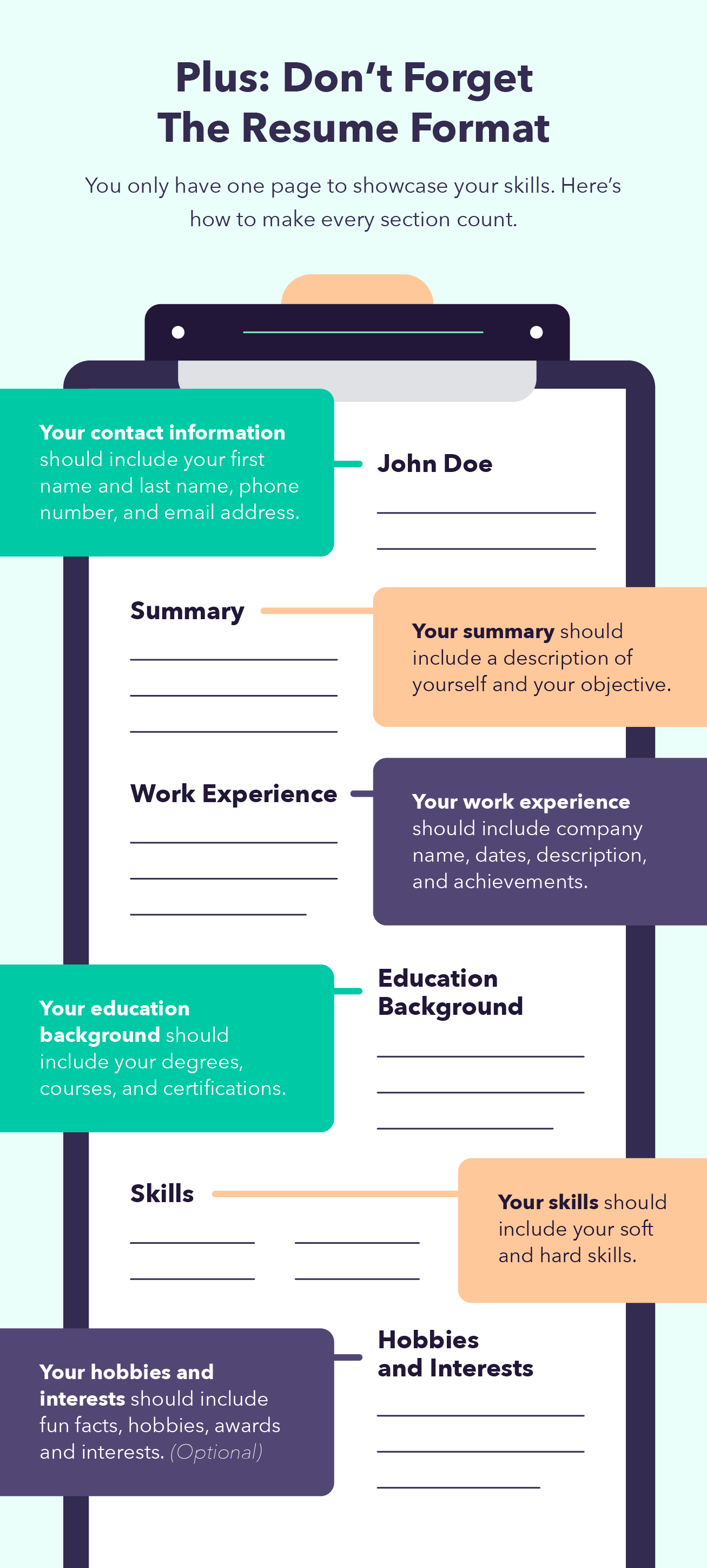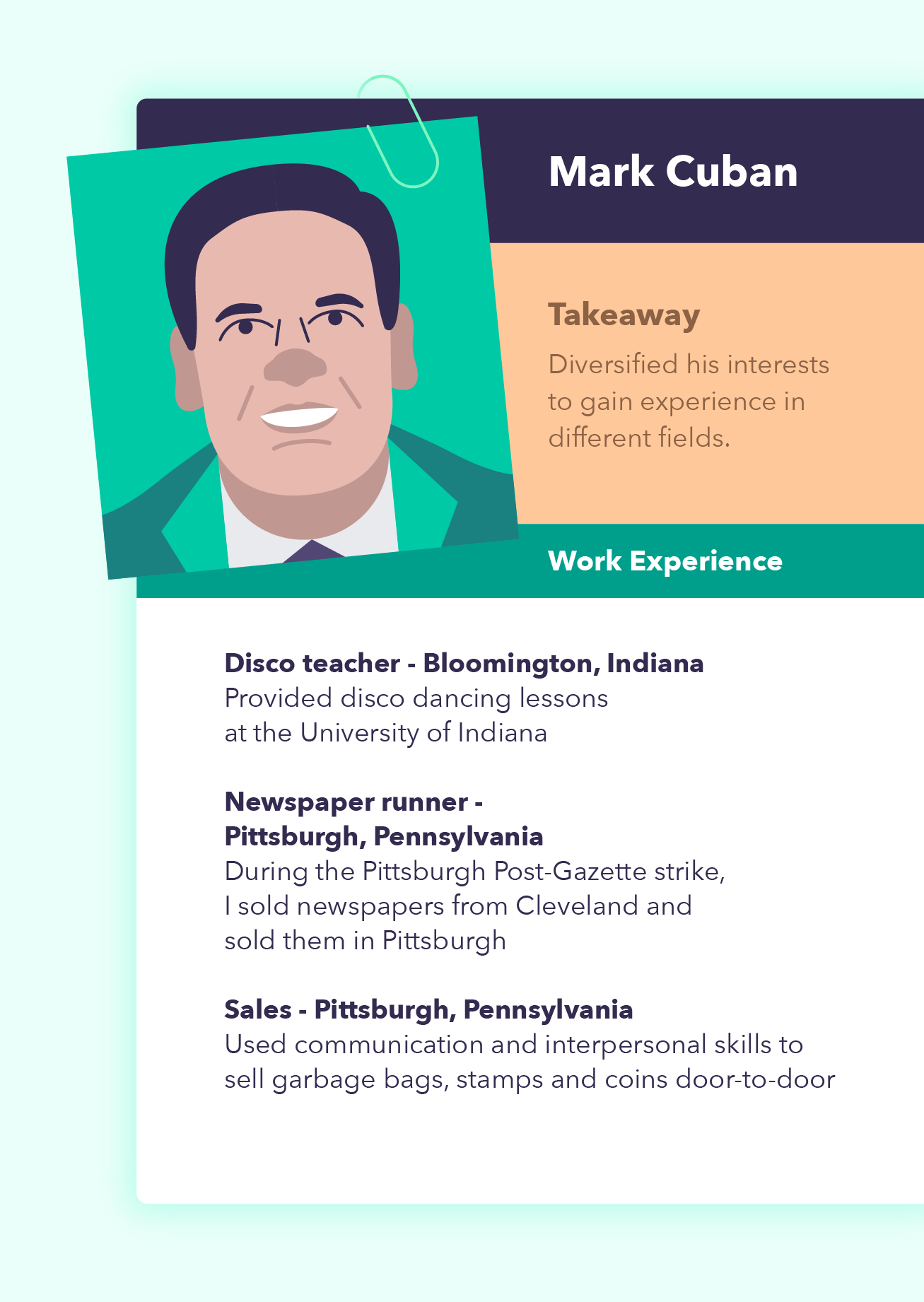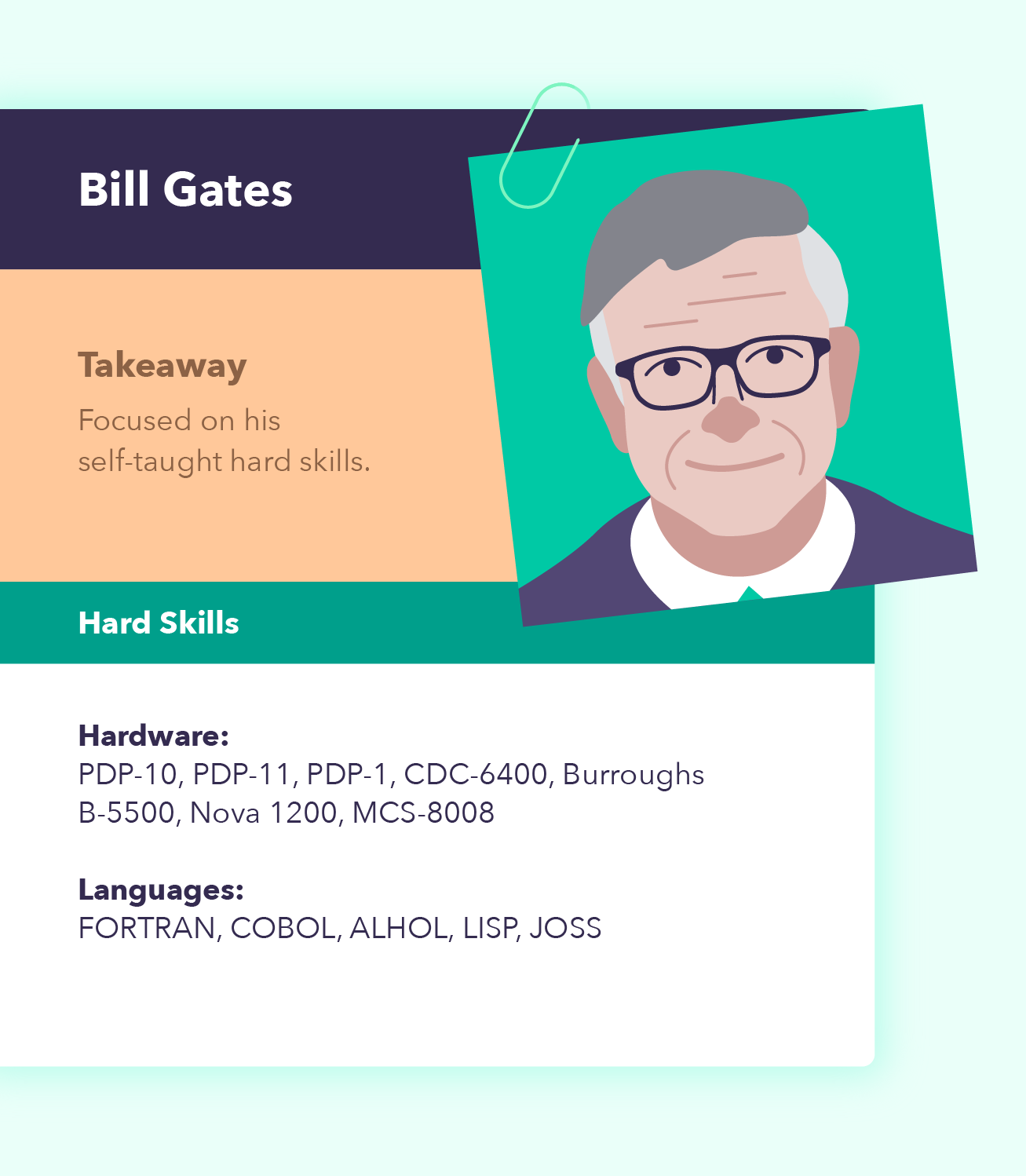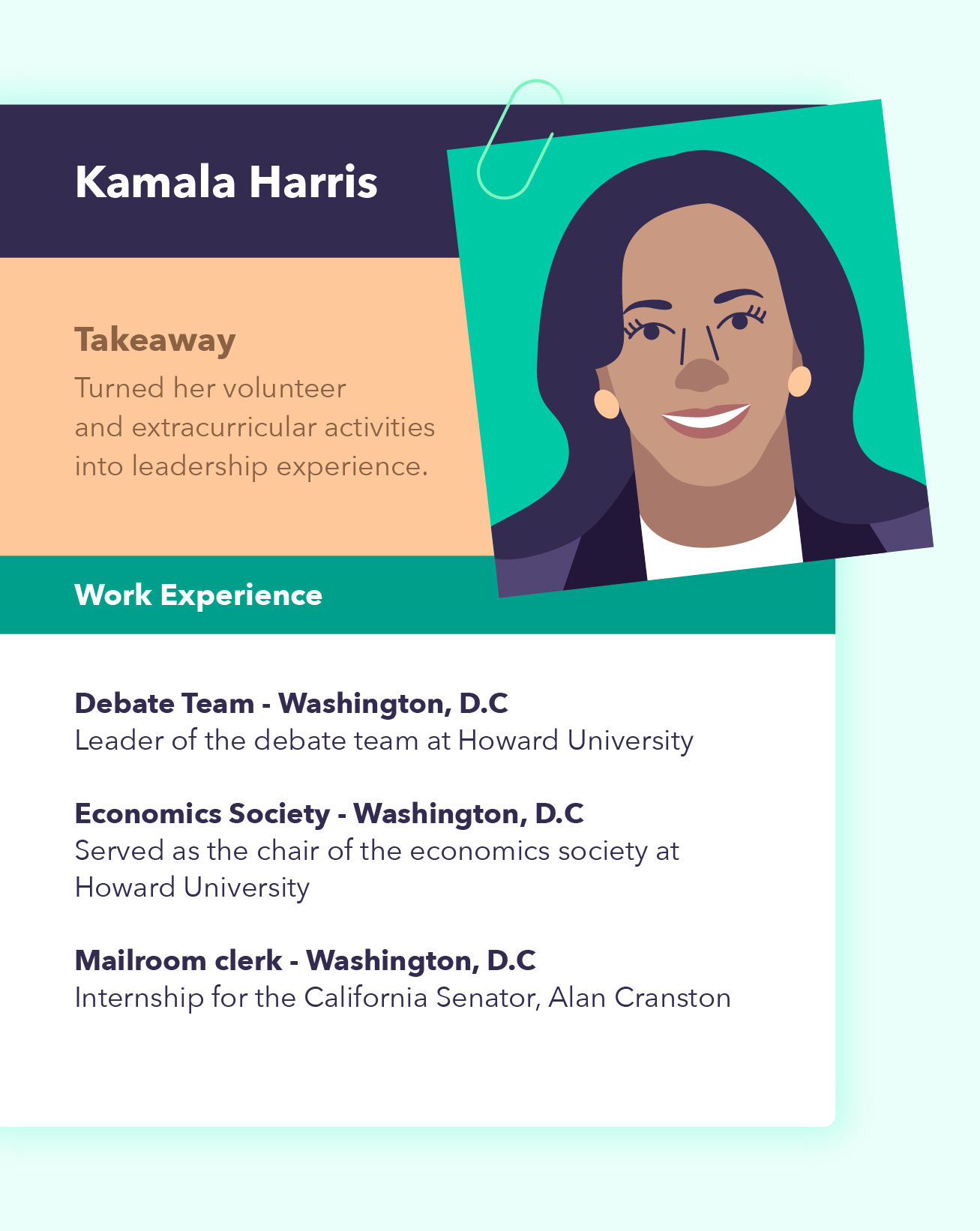How to Write a First Job Resume + A Downloadable Template for 2022: Selling yourself and your skills to a potential employer can be tough, especially if you lack relevant experience. Whether you’re drafting your first job resume or struggling to find work after college, this article will go over everything you need to put in your resume, even if you don’t think you have much to include.
Continue reading to understand what you can glean from successful people’s first job resumes, and then download our free first job resume template to get started on your own.
What Should Your First Job Resume Contain?
Maintain a concise and easy-to-read resume while delivering the most important information to the company.
It’s best to make it brief and easy to grasp. Because most employers receive a large number of resumes in a day, they will not have time to read through pages and pages of content—in fact, hiring managers to spend an average of six to eight seconds reviewing each resume.
Most first-time job resumes should include the following sections:
Name, phone number, and email address are required for contact.
Summary and goals: Describe yourself and your goals.
Work experience includes previous jobs, interests, and volunteer work.
High school and/or college education, courses, and certifications are required.
Competencies: Relevant abilities and accomplishments.
Hobbies and interests (optional): Interesting facts, hobbies, awards, and interests.

How to Write a Resume for Your First Job in 10 Easy Steps
Starting your first job CV can be intimidating, and you may feel as if you lack the relevant experience to bring to the workplace. However, by taking a step back and considering what you have accomplished in the previous years, you may still construct a terrific CV.
Have you ever volunteered to help a family member by babysitting on a couple of weekends in high school? Congrats! You’ve demonstrated that you can manage your academics while also using your communication skills and even temper to calm down a five-year-old.
Or perhaps you oversaw a lengthy school project for an after-school group. Excellent work! You’ve already proved your ability to lead.
Every experience, both within and outside of a professional workplace, can be counted toward your accomplishments on your first job resume. Even if you’ve never worked before, there are numerous ways to present your abilities and experience to prospective employers. To that end, here’s how to create your first employment resume.
1. Determine the Best Method for Organizing Your First Job Resume
The first step in creating your first job CV is deciding how to organise it.
If you’re a recent graduate or currently in school, you can have your education information appear first, followed by your professional experience. If you do have some experience to add, it may be a good idea to begin with that, as it is more relevant to an employer.
Here are three approaches to organising your first job resume:
Resumes in chronological sequence concentrate on your previous experience. Your experience should be given in reverse chronological order, thus your most recent employment or degree should be placed first, followed by previous roles. A summary, achievements, and certificates are also included in chronological resumes.
Functional resume: A functional resume focuses on your talents and abilities rather than your experience. If you don’t have much experience, this can be a terrific option because you can showcase your most relevant talents rather than your experience. This type of resume can assist you in demonstrating to the hiring manager that you are competent in performing the job.
Mixture resume: If you have some experience, particularly if it is unrelated to the position you’re going for, a combination resume may be a smart alternative for you. A combination resume combines both functional and chronological resumes, listing your talents and competencies first, followed by your experience in reverse chronological order.
2. Begin by providing your name and contact information.
Begin by providing your contact information once you’ve determined the best approach to organise your resume. Include the following in the page’s header:
your first and last name, your phone number, and your email address
You can also include your current location, a link to your LinkedIn page, and a link to your portfolio.
3. Look into Resume Keywords
Employers receive an average of 250 applications for each job posting, and 75% utilise applicant monitoring software. So, if you get a pair of rejection emails shortly after uploading your resume, it’s possible that it wasn’t properly suited for the post and was rejected by the programme.
That being said, it’s a good idea to conduct some keyword research before drafting your first resume to ensure that your abilities and experience fit the job description and enhance your chances of receiving an interview.
Examine the job descriptions for the roles you wish to apply for, paying special attention to the parts on requirements, qualifications, and duties. Make a list of some of the most prevalent terms you come across and compare them to your talents and expertise.
After that, you can edit your resume to include some of the keywords that are relevant to your experience.
4. Include Your Education and Skills
Now that you’ve decided on your chosen method of organising your first job resume as well as your customised keywords, it’s time to flesh out your resume by describing your talents and education.
Employers will be able to assess if you’re a suitable fit for the position in seconds if your talents and abilities are included in your CV, especially if you don’t have much experience. Include your education and experience in reverse chronological order so they can see what you’ve been working on in prior years.
5. Create Your Goal
A short summary section at the top of your resume, often known as your objective, is common. Write a few phrases about yourself, your relevant abilities, or what you intend to achieve in the workplace in this part.
Although some people choose not to include this area, it might be a quick method to demonstrate to the employer what you can offer. It can also show them if you’re a good fit for the position, which is especially important if this is your first work CV.
Here are some instances of resume targets that are both good and bad:
| Good Objective | Bad Objective |
|---|---|
| I am a highly-motivated and resourceful individual experienced in customer service and seeking to grow my knowledge of content marketing. | My objective is to find a good-paying position to show off my skills. |
| Recent high school graduate seeking an entry-level position in women’s retail. Hoping to showcase my customer service and communication skills. | Recent graduate looking to work for a company that fits my personality. |
| Actively searching for an entry-level position in healthcare to live out my passion for providing care. | Looking for a job in retail. Currently I have no experience but I am a hard worker and will do anything to get the job done. |
6. Highlight Soft and Hard Skills
When listing your skills on your first job resume, it’s advisable to include both soft and hard skills.
- Soft skills: Skills relating to your personality. These are usually hard to teach and can add great value. They can relate to your work ethic and how you interact with people.
- Hard skills: Skills that you have learned and are measurable. They are usually mastered and enhanced through practice, and you can typically learn them from classes and courses.
Here are some examples of soft and hard skills:
| Soft Skills | Hard Skills |
|---|---|
| Adaptability | Bilingual or multilingual |
| Communication | Programming languages |
| Problem-solving | Software knowledge |
| Time management | Marketing concepts |
| Ability to work under pressure | Academic degrees |
| Creativity | Computer skills |
7. Include Education and Certifications
Employers are interested in your education and qualifications when you apply for a job. Include your education, such as degrees, GPA (if 3.5 or better), and relevant coursework, as well as certifications, projects, and academic achievements, on your resume for your first job.
Add Volunteer and Extracurricular Activities to the list.
When you don’t have a lot of job experience, it’s very vital to include any volunteer and extracurricular activities on your resume. List any relevant activities and what you learned from them on your first employment CV. These will demonstrate that your real-world experience has aided in the development of your soft and hard talents.
9. Make it quick and simple.
The format of your initial resume is extremely important in the employment process. Keeping it short and simple will allow hiring managers to easily go through your CV and better comprehend the value you’re offering — in addition to demonstrating your organising skills.
Make sure the typeface on the resume is legible, such as Times New Roman, Calibri, or Cambria, and that it is at least 10 pts but preferably 12 pts.
Although the colours of your resume will vary depending on the field you’re going for, keeping it simple will help with legibility. Plan to have your resume typeface in black on a white background, with a third colour, such as blue or green, used to emphasise a title.
You can also try bolding, italicising, and CAPITALIZING areas you want to emphasise.
Consider a Customized Cover Letter.
Depending on the job, you may be needed to provide a cover letter as well. A cover letter will provide you with additional space to express yourself and demonstrate what you have accomplished and your goals.
The emphasis of your cover letter should be on what you can offer a particular firm. As a result, for each job you apply for, you should consider writing a tailored cover letter. Here is what you should put in your cover letter:
Getting in Touch
Name of the hiring manager or the name of the company
Greeting
Outstanding accomplishments
Reasons why you’re a good fit for the organisation and an excellent candidate
Understanding of the position for which you are applying
Formal Closing Examples of Successful People’s Resumes
Even the most successful and well-known people begin with a blank sheet of paper as their first CV. It takes time to gain experience and abilities to add to your CV, but with proper planning, you can construct a terrific first job resume.
To assist, consider how a few successful people’s CV sections would have looked when they had little to no experience – remember, we all started here!
Senator Kamala Harris
Kamala Harris committed her life to learn and seeking societal improvement before becoming a deputy district attorney and the Vice President of the United States. If Kamala Harris were to write her first job resume before attending law school, it may look like this:
Because Kamala spent a significant amount of time at university working on her degree and aspired to be a lawyer, it was critical for her to prioritise her educational experience.
The experience Kamala mentions, such as job and extracurricular activities, relates to leadership, which she has built a career out of. This is especially useful when a profession demands both technical training and the development of soft and hard skills.
Cuban, Mark
Mark Cuban’s journey to becoming a billionaire and eventual owner of the NBA’s Dallas Mavericks was not without challenges. Prior to his achievement, he worked in a variety of jobs and ventures. If Mark Cuban were to create his first résumé in college, he would almost certainly include some of his hobbies and interests.

Mark Cuban returned to Pittsburgh after graduating from Indiana University and taking a position at Mellon Bank. Despite the fact that his degree helped him get a job after college, he didn’t have much formal employment experience.
Mark Cuban broadened his interests and pastimes in order to obtain knowledge in other industries, which he later used to diversify his business portfolio as a mega-investor. Highlighting how you developed diverse interests and talents will help you stand out from other applicants with comparable levels of experience and education.
Mr. Bill Gates
Resumes have evolved significantly throughout the years. Take a look at Bill Gates’ résumé from 1974 as an example. We now use a different style for resumes, but we can still learn a lot from Gates’ resume’s skills and experience part. This is how that part would have looked when he initially started out:

Bill Gates uses his self-taught hard skills in his favour when writing his first job resume. He taught himself so many programming languages and ultimately created his own empire. It can be a good practice to include relevant courses during school, project accomplishments, and descriptions of each.

The Bottom Line
Every successful person at some point had to write their first job resume. Identifying your accomplishments and skills, along with your personality traits, can help you build a resume that could potentially lead to a great first job.

The post How to Write a First Job Resume + A Downloadable Template for 2022 appeared first on MintLife Blog.
The post How to Write a First Job Resume + A Downloadable Template for 2022 appeared first on https://gqcentral.co.uk


